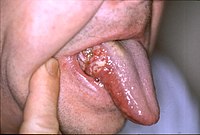
Photo from wikipedia
In this editorial, we provide a broad review of the consequential modifications in the newly released 4th edition of the WHO head and neck tumor classification, comment on two selected… Click to show full abstract
In this editorial, we provide a broad review of the consequential modifications in the newly released 4th edition of the WHO head and neck tumor classification, comment on two selected reviews in this volume of the journal, and succinctly discuss the changes made in the salivary gland tumor chapter [1–3]. In general, the new edition represents a streamlined and simplified version from previous editions in an effort to reduce redundancy and to maintain consistency within and between different chapters and topics [4]. This task has been achieved through presenting tumor entities to the sites of their most common occurrence and presentation. Sometimes, however, exceptions to this rule have been made in limited entities for either prominence or their relevance to diagnosis and differential diagnosis at certain sites. For the first time in this edition, chapters devoted to the oropharyngeal and the neck region were established. Their inclusion was based on the distinctive structures and tumor types and their relevance to the differential diagnosis andmanagement of patients with tumors at these regions, especially regarding HPV-associated squamous cell carcinoma for the oropharynx which bears profound epidemiologic and therapeutic consequences. Efforts were also made to adopt similar nomenclature and classification of entities commonly included in other WHO tumor classifications of different organs. This is particularly notable in the classification of neuroendocrine tumors, paraganglioma, soft tissue, and lymphoreticular disorders. In this volume of the journal, together with this editorial, detailed reviews of the significant changes that have been implemented in the nasal, paranasal and skull base, and odontogenic tumor chapters are thoroughly presented [2, 3]. In these reviews, the authors addressed the rationale for accepting new entities and modifying nomenclatures and classification of others. The nasal skull-base section, in particular, detailed the characteristics of newly accepted entities and addressed the status of certain emerging entities to clarify their use in diagnosis and differential diagnosis. Similarly, the review of the odontogenic chapter addresses the wide-ranging changes and modifications in comparison to previous editions of the blue book. In particular, the inclusion of odontogenic cysts represents a significant addition that was felt to be integral to the differential diagnosis of several odontogenic tumors. The review also addresses changes in terminology, neoplastic nature, and the inclusion and exclusion of certain lesions; the outcome being a significant reduction in the number of entities within the group odontogenic lesions. We fully contend that awareness of these changes is critical to the implementation of these pathologists for modification for consistent diagnosis and proper management of these tumors. Several notable changes have also been made in the salivary gland tumor chapter. Among these is the inclusion of hyperplastic conditions with significant differential diagnostic relevance encompassing sclerosing polycystic adenosis, nodular oncocytic hyperplasia, and intercalated duct hyperplasia [5, 6]. Similar to the policy for other chapters in the 4th edition, the discussion of lymphoproliferative disorders in the salivary tumor chapter was limited to those commonly identified in salivary glands with a focus on extranodal marginal zone and mucosa-associated lymphoma (MALTsyndrome) as the most common type of lymphomas, in this area [7]. Because of their commonly shared features and presentations, both exophytic and inverted ductal papillomas were combined See related article, https://doi.org/10.1007/s00428-017-2182-3; https:// doi.org/10.1007/s00428-017-2116-0
Journal Title: Virchows Archiv
Year Published: 2018
Link to full text (if available)
Share on Social Media: Sign Up to like & get
recommendations!